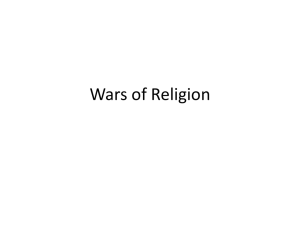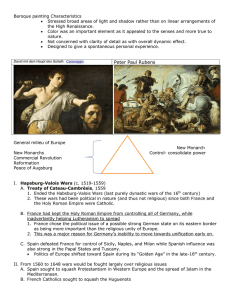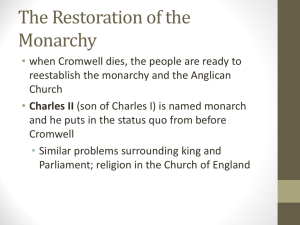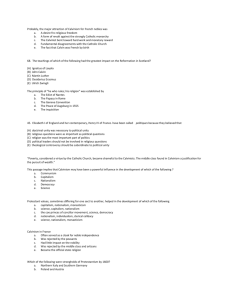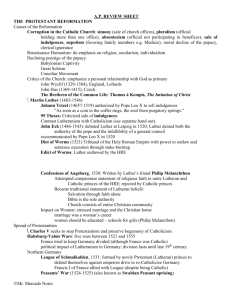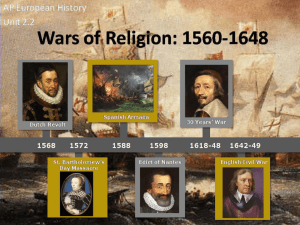French Civil Wars
advertisement
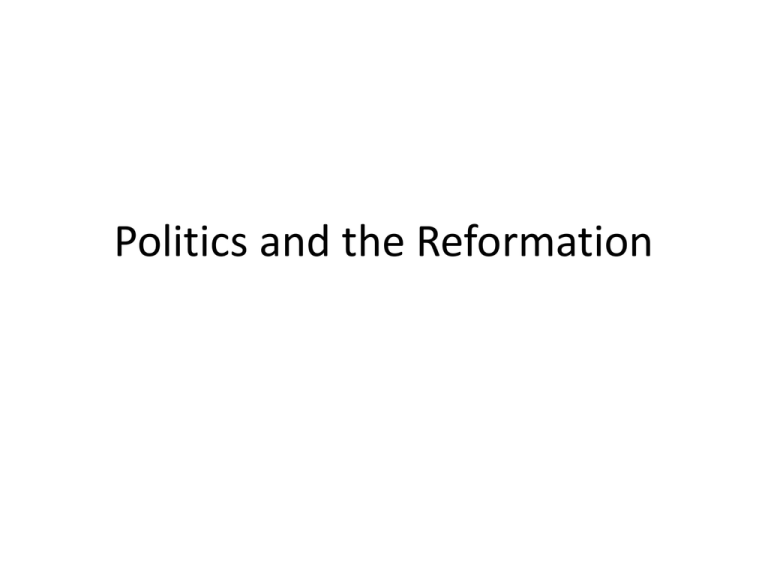
Politics and the Reformation Summary From 1560 to 1648 wars would be fought largely over religious issues • A. Spain sought to squash Protestantism in Western Europe and the spread of Islam in the Mediterranean. – “Golden Age” of Spain • B. French Catholics sought to squash the Huguenots • C. The Holy Roman Empire sought to re-impose Catholicism in Germany • D. The Calvinist Netherlands sought break away from Spanish rule • E. England dealt with the Protestant/Catholic identity, eventually leading to a civil war. – John Knox est. Presbyterianism in Scotland Confession of Augsburg 1530 - an attempted compromise statement of religious faith to unite Lutheran and Catholic princes of the HRE – Rejected by Catholic princes, leading to war • Became traditional statement of the Lutheran Church – Salvation through faith alone – Bible is the sole authority – Priesthood of all believers‖: Church consists of entire Christian community • Emperor Charles V sought to stop Protestantism and preserve the hegemony of Catholicism • Allied with the pope in trying to stamp out heresy • Charles was preoccupied with the Turkish threat in Hungary and his dynastic struggle with Francis I of France. – a. Between 1521 & 1530 Charles was away from the HRE, much of the time spent in Italy – b. Thus, Charles could not focus his military solely on the HRE at a time that Protestantism was spreading vigorously League of Schmalkalden, 1531 in N. Germany a. Formed by newly Protestant (Lutheran) princes to defend themselves against Charles V’s drive to re-Catholicize Germany. b. Francis I of France allied with the League (despite being Catholic) Habsburg-Valois Wars Five wars between 1521 and 1555 involving French monarchs and the Hapsburgs – a. France tried to keep Germany divided (although France was Catholic) – b. This conflict played an important role in retarding unification of the German states • c. Catholic unity in Germany never again occurred • Charles was finally victorious over the League in 1547 a. However, by that time Lutheranism had spread and taken hold in much of Central Europe. b. Charles by the 1550s was forced to give up on restoring Catholicism in all the German states in the empire. Peace of Augsburg (1555) Temporarily ended the struggle in Germany over Lutheranism • Provisions: – Princes in Germany could choose either Protestantism or Catholicism – Cuius regio, eius religio—―whose the region, his the religion. – Protestants living in Catholic states were allowed to move to Protestant states. The same was true of Catholics living in Protestant states. • Resulted in permanent religious division of Germany • Essentially reaffirmed the independence of many German states • This division stunted German nationalism; Germany was not unified as a state until 1871. France French Civil Wars (at least 9 wars between 1562-1598) – After the death of Henry II in 1559 a power struggle between three noble families for the Crown ensued • St. Bartholomew Day Massacre (August, 24, 1572) • Marriage of Margaret of Valois to Protestant Huguenot Henry of Navarre on this day was intended to reconcile Catholics and Huguenots. • Protestant rioting occurred when a Huguenot noble was murdered. • 20,000 Huguenots killed in response over the next few months. • The massacre initiated the War of the Three Henrys: civil wars between Valois, Guise, and Bourbons “A Chicken in every pot” Henry IV (Henry of Navarre) (r. 1589-1610): a politique • Sought practical political solutions • He converted to Catholicism to gain the loyalty of Paris – “Paris is worth a mass” – Privately he remained a Calvinist • Issued Edict of Nantes, 1598: granted a degree of religious toleration to Huguenots • Permitted Huguenots the right to worship privately • Public worship, however, was not allowed • Huguenots not allowed to worship at all in Paris and other staunchly Catholic cities. • Gave Huguenots access to universities, to public office, and the right to maintain some 150 fortified towns in west and southwestern France for self-protection. • In reality, the Edict was more like a truce in the religious wars rather than recognition of religious tolerance. • Nevertheless, the Edict gave Huguenots more religious protection than perhaps any other religious minority in Europe. Summary From 1560 to 1648 wars would be fought largely over religious issues • A. Spain sought to squash Protestantism in Western Europe and the spread of Islam in the Mediterranean. – “Golden Age” of Spain • B. French Catholics sought to squash the Huguenots • C. The Holy Roman Empire sought to re-impose Catholicism in Germany • D. The Calvinist Netherlands sought break away from Spanish rule • E. England dealt with the Protestant/Catholic identity, eventually leading to a civil war. – John Knox est. Presbyterianism in Scotland SAQ - Independent Historians have argued that the success of the Protestant Reformation (15th through 16th centuries) was primarily due to political developments in Europe. • (A) Identify TWO pieces of evidence that support this argument and explain how each supports the argument. • (B) Identify ONE piece of evidence that undermines this argument and explain how the evidence undermines the argument.

